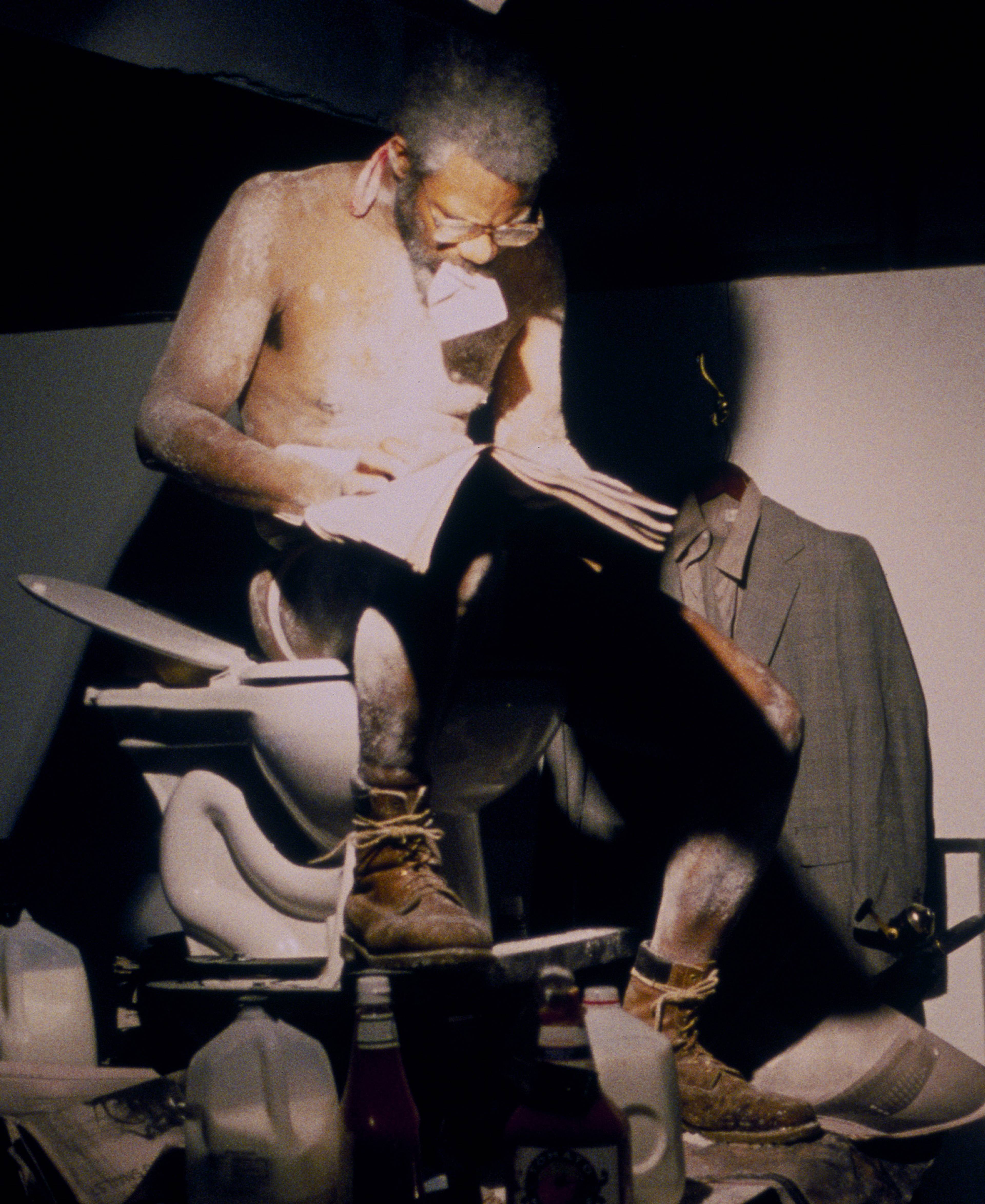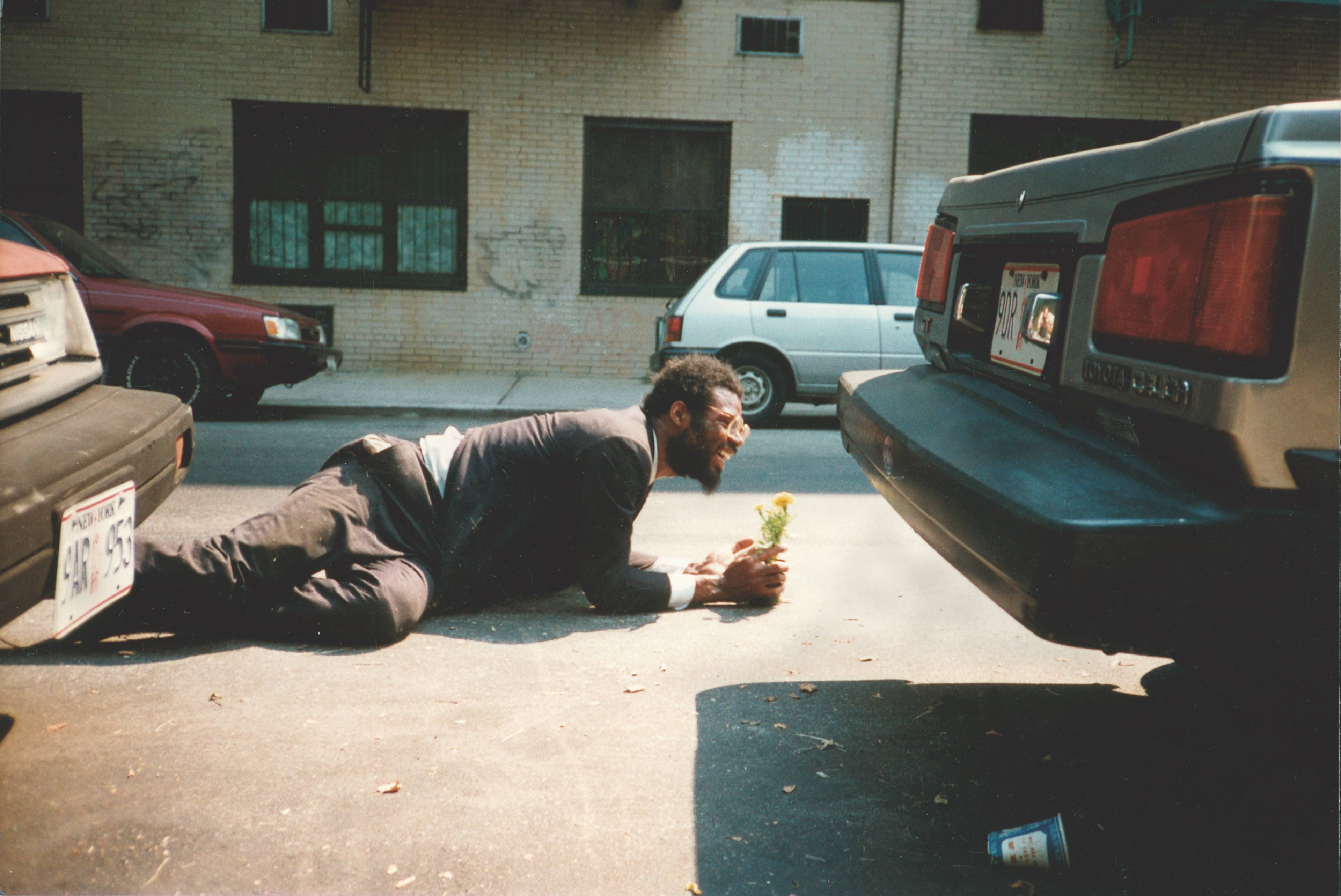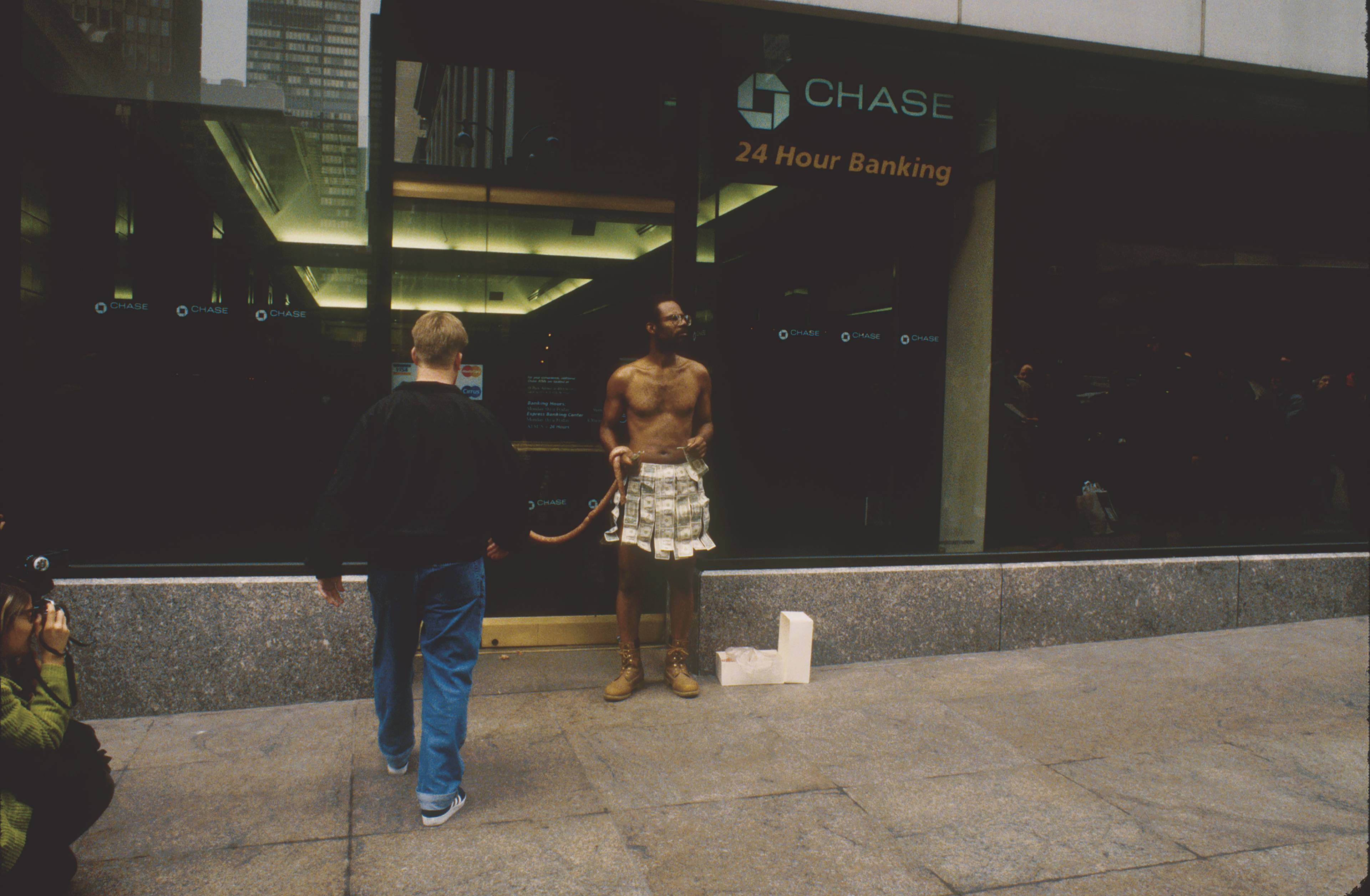18 July 1991 was a blistering New York summer day, when temperatures reached 101 degrees Fahrenheit. In Manhattan’s East Village, Pope.L (1955–2023) was squirming and writhing in the street alongside Tompkins Square Park, wearing a black suit and white oxford shirt and clutching a small, potted yellow flower in one hand, seemingly with no other objective than to proceed on a course known only to him. The performance, titled Tompkins Square Crawl, was stopped after only one block, however, by a police officer summoned by a black spectator who was dismayed at and confused by what he perceived to be a malicious intent on the part of the artist. Pope.L had asked that he be let alone “to do my work” and offered to talk with him when the piece ended. To no avail.
This encounter points to the uncanny dimension of abjection, which resides in the fact that it occurs only insofar as there is a prick of recognition on the part of the person experiencing it. It also – and especially – relates to the long and troubled history of the representation of blackness in visual culture, marking how the racially black body is deprived of agency by being perceived as a standing for all black beings. Pope.L’s capacious deployment of blackness as a mode, means, and material in the drawings, paintings, sculptures, installations, videos, writing, and most notably performances that make up his practice since the 70s has offered the artist a way to explore and probe the relation of race to capitalism, the historical and economic system of modernity in which both the United States and its concept of race have their origins. Indeed, the flower Pope.L carried in Tompkins Square Crawl can perhaps be read as a metaphor for the seeds of a system in which such things take root and grow.
Tompkins Square Crawl, from the series “How Much is That Nigger in the Window,” 1990–91
The Great White Way, 22 miles, 9 years, 1 street (Whitney version), 2001. Photo: Lydia Grey
Tompkins Square Crawl is one of more than thirty such performances the artist undertook during his lifetime. The first was Times Square Crawl (1978), an introspective choreography to do in part with homelessness and “giving up verticality,” in the artist’s words. The best known of them is The Great White Way, 22 Miles, 9 Years, 1 Street (2001–09), for which Pope.L donned a Superman costume with a skateboard strapped to his back in place of the cape as he traversed the full length of Broadway, each portion lasting as long as the artist could withstand the grueling undertaking.
From the very beginning, the crawls were conceived as potential group performances, although it would take many years before this aspect of the work would be realized. A collective crawl took place at the Abyssinian Meeting House in Portland, Maine, on 5 October 2002, where, at the time, Pope.L was a professor at Bates College. For “Prospect.2 New Orleans,” after the devastation of Hurricane Katrina, the artist put on Blink (2011), a twelve-hour event involving sixty-five volunteers hauling a black ice-cream truck ten miles from the Lower Ninth Ward to Mid-City. (It featured a rear projection screen that displayed images, sourced from local residents, that had to do with dreaming and waking up in the city.) Similarly, in Pull! (2013), Pope.L and Cleveland locals pulled an eight-ton GMC step van (an all-purpose “work-horse” vehicle) by hand for more than twenty-five miles and seventy-two consecutive hours. Pope.L’s investment in collective action in communities that have experienced severe economic and environmental devastation reveals a commitment to what Trinidadian Marxist writer and activist C.L.R. James called “creative social power,” achieved through the construction of new social relations by the shared creative work of the assembly.
Eating the Wall Street Journal (street version), from the series “How Much is That Nigger in the Window,” 1990–91
Foraging (Animal Husbandry), 1995–2001, archival Iris print, unique, 89 x 119 cm
Assembly, or, better, assemblage – the adding of one individual thing to another until they take on new significance, able to stand alone and also gaining new possibilities when taken as a whole – is a key part of Pope.L’s artistic process. In Eating the Wall Street Journal (1990–91), the artist consumes America’s best known daily financial newspaper while seated on an American flag, wearing the same aspirational attire as in Tompkins Square Crawl. When Pope.L revisited this work at SculptureCenter in New York in 2000, the artist sat perched on a white toilet, wearing a white jockstrap and glasses and covered in flour that formed a crust on his body from milk and saliva. He was surrounded by pages of the newspaper and lit by a single aluminum clip light. For approximately three hours, over the course of five days, the artist periodically ate small portions of the Journal, at times adding ketchup or taking a drink of milk. From the first version of the piece, Pope.L had learned that newsprint contained chemicals that should not be consumed, so he spat out the chewed-up shreds, which inevitably accumulated over the duration of the piece, alongside the emptied milk containers that had been cast to the ground.
For another work, on view at the Horodner Romley Gallery in New York in 1992, Pope.L installed a ten-foot “fresco” titled Harriet Tubman Spinning the Universe, painted within a few hours from peanut butter, acrylic and latex paints, joint compound, charcoal crayon, and a news clipping, as well as several sculptures and drawings on edible Americana, such as Pop Tarts and Cracked Wheat Biscuits. The artist positioned himself for the duration of the show on a plush, well-worn armchair in the center of the gallery with a milk crate in front of him, on which sat a bottle of milk of magnesia, for “the socially and politically constipated.”
To exhaust is not to be tired; it is the will to begin again. In this regard, it is to prepare for what is possible, as well as to exhaust all possibilities.
The ongoing relation between concepts and matter recurs across his entire oeuvre. It was poignantly marked in his 2015 exhibition, “Trinket,” presented by the Museum of Contemporary Art at the Geffen Contemporary in Los Angeles. Among the nine works in the show was The Polis or the Garden or Human Nature in Action (2015), an installation composed of hundreds of onions, the majority of which were half-painted in variations of blue, red, and white, and some in green or black, covering long white tables with black legs and supports. Pope.L has suggested that this poetic meditation on the relation between time and decay “produces or flattens or equalizes difference and at the same time it can emphasize it.”
The exhibition’s centerpiece, however, was Trinket (2008/2015), a mammoth, 16-by-45-foot American flag featuring one added star, which was blown by four of the industrial fans commonly used on movie sets and lit up by fifteen stage lights. The force of the manufactured wind slowly frays the incessantly swaying national emblem, an undoing over time and under extreme conditions, excepting at the end of each day, when it is taken down, folded, and stored away. (In an earlier iteration in 2008, at the Municipal Auditorium in Kansas City, the flag was blown twenty-four hours a day for one week.)
A.T.M Piece, New York, 1997
View of “Trinket,” Geffen Contemporary at MOCA, Los Angeles, 2015. Photo: Brian Forrest
The sense of the exhaustion of America in the increasingly battered and frayed flag in Trinket can be understood in conjunction with Blind (2015), seemingly a black monochrome painting that was actually a square opening in a gallery wall, through which a stream of air seeped from the Trinket fans. Blind suggests itself as a metaphor for how Pope.L, armed with precarity and all the seriousness of play as aesthetic tools, swerves in an illogical, yet very real void, productively using structured chance as a vehicle for emotional resonance and the unwieldy potential of affect to the point of exhaustion in his artwork.
This notion of structured chance leads to Cage Unrequited (2013), for which, over the course of twenty-five hours, some seventy-five artists, scholars, musicians, students, and curators took turns reading portions of John Cage’s Silence: Lectures and Writings (1961), with an interlude around midnight in which Pope.L talked about Julian Eastman, a black, gay avant-garde composer, who had undressed his boyfriend while performing Cage’s Song Books (1970), and also attempted to undress his sister. Pope.L’s act of homage to the composer thus also took on the tone of a critical, antagonistic act of filial (im-)piety. Surprisingly this was accentuated when, in the predawn hours, the lobby was unexpectedly occupied by two bands from the Black Rock Coalition. The sudden proximity of a reading about silence and Afropunk music remains in my memory as a sublime example of contrary dimensions of black matter – unleashed and exhausted.
As philosopher Gilles Deleuze has it, to exhaust is not to be tired; it is the will to begin again. In this regard, it is to prepare for what is possible, as well as to exhaust all possibilities. Pope.L’s willingness to endure in his performances, to reformulate our experience of subjectivity, and to repeat materials such as milk, peanut butter, newspaper, and icons like the American flag and Superman costumes, and to reformulate our experience of collectivity is about exhausting limitations in order to know what, indeed, is possible. Like the black hole that forms when a star collapses, it is an exploration in new ways of creating value. Black experience is peculiarly and particularly capable of illuminating the circumstances of American society in general. It is our central contradiction. As Pope.L explained: “I have always been at the heart of what is American in being black, so if there is fringing going on, it’s the typical, knotty kind where one can be most central yet so much on the edges.” Exhaustion is the pursuit within and beyond such locations. It is where possibility is marked with meaning.
White People are a Desalination Plant in Puerto Rico, 2001, mixed media on paper, 28 x 22 cm
Blue People Are A Drop Of Halter, 2012, mixed media on paper, 31 x 23 cm
___










